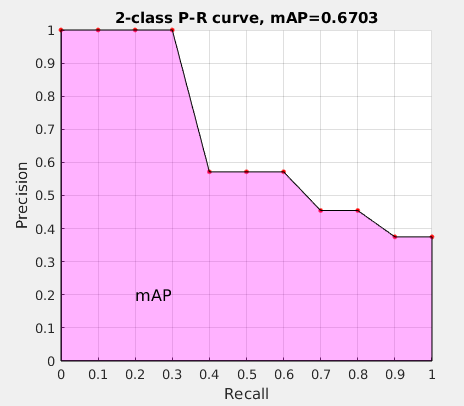1. Precision和Recall
对于二分类问题,可将样例 根据其真实类别与学习器预测类别的组合划分为:
- TP (True Positive): 预测为真,实际为真
- FP (False Positive): 预测为真,实际为假
- TN (True Negative): 预测为假,实际为假
- FN (False Negative):预测为假,实际为真
令 TP、FP、TN、FN分别表示其对应的样例数,则显然有 TP + FP + TN + FN = 样例总数
分类结果的 “混淆矩阵” 如下:
| 实际为真 T | 实际为假 F | |
|---|---|---|
| 预测为正例 P | TP (预测为1,实际为1) | FP (预测为1,实际为0) |
| 预测为负例 N | FN (预测为0,实际为1) | TN (预测为0,实际为0) |

\[ (查准率)Precision = \frac{TP}{TP + FP} \\ \\ \\ {\color{Purple}{(预测的好瓜中有多少是真的好瓜)}} \]
\[ (查全率)Recall = \frac{TP}{TP + FN} \\ \\ {\color{Purple}{(所有真正的好瓜中有多少被真的挑出来了)}} \]
2. P-R曲线
一般来说,查准率高时,查全率往往偏低,而查全率高时,查准率往往偏低。通常只有在一些简单任务中,才可能使得查全率和查准率都很高。在很多情况,我们可以根据学习器的预测结果,得到对应预测的 confidence scores 得分(有多大的概率是正例),按照得分对样例进行排序,排在前面的是学习器认为”最可能“是正例的样本,排在最后的则是学习器认为“最不可能”是正例的样本。每次选择当前第 \(i\) 个样例的得分作为阈值 \((1 \leq i \leq 样例个数)\),计算当前预测的前 \(i\) 为正例的查全率和查准率。然后以查全率为横坐标,查准率为纵坐标作图,就得到了我们的查准率-查全率曲线: P-R曲线
举例说明:以下摘自 多标签图像分类任务的评价方法-mAP
在一个识别图片是否是车,这样一个二分类任务中,我们训练好了一个模型。假设测试样例有20个,用训练好模型测试可以得到如下测试结果: 其中 id (序号),confidence score (置信度、得分) 和 ground truth label (类别标签)

接下来对 confidence score 排序,得到:

然后我们开始计算P-R曲线值,将排序后的样例,从 \(i = 0\) 到 \(i = 20\) 遍历,每次将第 \(i\) 个样例的 confidence scores 做为阈值,前 \(i\) 个预测为正例时,计算对应的 Precision 和 Recall。
例如,当 \(i = 1\) 时,预测了一个做为正例,其余的都预测为反例,此时的阈值为 0.91。 此时的 TP=1 就是指第4张,FP=0,FN=5 为第2、9、16、7、20 的图片,TN=15为13,19,6,1,18,5,15,10,17,12,14,8,11,3。Precision = TP/(TP+FP) = 1/(1+0) = 0 ;Recall = TP/(TP+FN) = 1/(1+5)=1/6 。接着计算当 \(i = 2\) 时,以此类推…
为了便于理解,我们再讲一个例子当 \(i = 5\) 时,表示我们选了前5个预测结果认为是正例(对应圆圈中的TP和FP),此时阈值为0.45,我们得到了 top-5 的结果如下:

在这个例子中,TP 就是指第4和第2张图片,FP 就是指第13,19,6张图片。方框内圆圈外的元素(FN和TN)是相对于方框内的元素而言,在这个例子中,是指 confidence score 小于当前阈值的元素,即:

3. ROC 与 AUC
ROC 全称是“受试者工作特征”(Receiver Operating Characteristic)。ROC 曲线的面积就是 AUC(Area Under the Curve)。AUC用于衡量“二分类问题”机器学习算法性能(泛化能力)。
思想:和计算 P-R 曲线方法基本一致,只是这里计算的是 真正率(True Positive rate) 和 假正率(False Positive rate),以 FPR 为横轴,TPR 为纵轴,绘制的曲线就是 ROC 曲线,ROC 曲线下的面积,即为 AUC
\[ (真正率)TPR = \frac{TP}{TP + FN} \]
\[ (假正率)FPR = \frac{FP}{FP + TN} \]
4. mAP
接下来说说 AP 的计算,此处参考的是 PASCAL VOC CHALLENGE 的计算方法。首先按照 R-P曲线 计算方式计算 Precision 和 Recall。然后设定一组阈值,[0, 0.1, 0.2, …, 1],计算 Recall 大于第 \(i\) 个阈值的R-P集合中,对应的 Precision 的最大值。这样,我们就计算出了11个 Precision。mAP 即为这11个 Precision 的平均值。这种方法英文叫做 11-point interpolated average precision
相应的Precision-Recall曲线(这条曲线是单调递减的)如下:

AP 衡量的是学出来的模型在每个类别上的好坏,mAP 衡量的是学出的模型在所有类别上的好坏,得到 AP 后 mAP 的计算就变得很简单了,就是取所有 AP 的平均值。
5. 代码简单实现
1 | % Creation : 25-Apr-2018 16:01 |
结果图:

6. Reference
- 周志华老师 《机器学习》
- 多标签图像分类任务的评价方法-mAP
- 目标检测评价标准-AP mAP